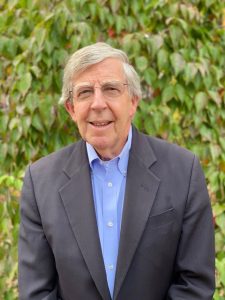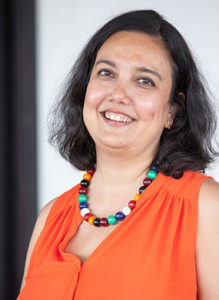It’s been a long trek since Doug Miller and four others set up the EVPA and it has taken in the creation of other social investing networks on the way, most recently the International Venture Philanthropy Center (IVPC)[1].
In November, he stepped down from the Chair to be succeeded by Naina Subberwal Batra, CEO of AVPN, who will combine the two roles. Alliance talked to them both about the development of the various regional associations, about the need to make heard the voices of the unheard, about the need to get money and know-how to where it is needed and about the role of philanthropy in the age of blended finance.
Andrew Milner: Can you set the background on IVPC. What need is it meant to answer?

Doug Miller
Doug Miller: When we started the EVPA, we had the idea that it would become global at some point, but we also had a very specific strategy which was to have each of the regional membership organisations have their own board of governors because they were closer to the activity and that’s worked very well. On the other hand, four or five years ago, we thought we really needed more collaboration and coordination between these regional membership organisations, so, first, we created a liaison activity then we said, ‘let’s take it to the next step.’
Naina Batra: If you really think about the scale of today’s challenges, whether you’re talking about climate, gender or the future of work and livelihoods, these are all global and you need an integrated approach to solve them. Having a network in each of the geographies helps us focus on a locally tailored solution, aimed at the same global problem. That is the first reason IVPC is needed. The second is that, if you look at the big philanthropic capital that has been flowing in the last five years, it’s coming from funders who have a very global outlook. so IVPC will help us work with funders who have that global outlook and would like to work on global solutions, but yet, make sure that regional contexts are taken into account.
Is it also a research body to inform the work of the various regional bodies?
 NB: No. It’s not a knowledge hub, beyond sharing key insights that could be useful when you are looking to scale a locally driven solution. The other thing to remember is that most of the current global structures have a very US/European outlook. If we are looking at the climate question and we want to encourage Africa or Latin America to take up alternative sources of energy, we need to have them at the decision-making table, so hopefully what we are doing is creating a platform where you can have the end-beneficiaries share with global funders with an international remit what is really needed.
NB: No. It’s not a knowledge hub, beyond sharing key insights that could be useful when you are looking to scale a locally driven solution. The other thing to remember is that most of the current global structures have a very US/European outlook. If we are looking at the climate question and we want to encourage Africa or Latin America to take up alternative sources of energy, we need to have them at the decision-making table, so hopefully what we are doing is creating a platform where you can have the end-beneficiaries share with global funders with an international remit what is really needed.
Who do you expect it to interact with on a global level?
NB: Aside from those global funders, we also look at engaging on global stages like COP, and we had a presence at COP both this year and last year. Allie [Hollowell, COO of IVPC] is also looking at whether we can create a presence at UNGA next year. We want to be where there is global decision-making and represent those interests that are not there already.
You talk about the regional organisations as a family, but the members have developed differently because of different circumstances. Clearly, you’ll have anticipated this, but have they developed in some ways that have taken you by surprise?
DM: First of all, I would say the DNA of all four networks, their mission and purpose is the same, but you have diversity even between and within continents, so we’re bringing global knowledge and global programmes, but solutions have to adapt to local conditions. What’s done in India and in Japan, or in Brazil and Argentina is going to be quite different. We’re also going to be developing what I call content partners. Naina mentioned climate and workforce development, and we will work with organisations that have lots of expertise in particular fields and who can bring those skillsets and ideas to the local networks. We are a connector.
NB: Each network has developed in a different market. You’ve watched us (AVPN) in all our beauteous colours and you understand how we’re serving a very wide range of capital providers now. Part of the reason for that is that there wasn’t and still isn’t much infrastructure for philanthropy or for different types of capital deployment in Asia, while people see Africa through a development lens, so there has been very little initiative to really look at social investment as something that is driven indigenously. In Latin America, there is a good amount of social investment activity happening but it is often unseen. The result is that all three tend to be overlooked on global platforms. That is something we have to change and having a platform that gives equal footing to these organisations that have developed in different ways I think is a great goal. Attitudes are very different across the regions and while initially, the thought was to copy or follow what came before, AVPN, EVPA, AVPA and Latimpacto are all very different. We have common DNA, we are like siblings, but each with our very own strong personalities and there’s nothing wrong with that. In fact, it is a strength.
You’ve talked generally about this but can you put your finger on the key differences between the regions?
NB: When Doug started EVPA, you had the European Union, one currency, open borders, so someone in France could decide they wanted to do something in Germany and it wasn’t a problem. Once you get to Asia and try to do cross-border giving, it’s very difficult. Economically over the last decade, Asia has seen a lot of economic progress. In Africa, we’re just seeing the beginnings of local wealth accumulation and there has been a big history of aid dependency which is now starting to shift. For Latin America, again, completely different. I think in Latin America, the presence or lack of democracy and good governance has been a big issue where development is concerned, though apart from Brazil, population numbers are not such an issue as they are for Africa or for Asia. Despite the proximity to the United States, a lot of US funders don’t really look at funding Latin America, possibly because it is seen as a middle-income region but it is also the region with the highest levels of inequality and the greatest biodiversity on the planet. So how do you galvanise local funders to act in that market and how do you bring international funders in as true partners? Each is different and IVPC has to take account of that but in the last two years, as IVPC got moving and as Allie came on board, we are seeing more cooperation, more collaboration, more sharing and exchange of knowledge.
DM: One of the trends that we have seen over the last three to four years is what we call the continuum of capital and that is the synergies between the philanthropic and impact investment capital and the need for the philanthropic capital to be there to generate deal flow for impact investment. That’s been a big change and AVPN was the champion of that within the network.
Naina, your work with AVPN has immersed you in the Asian region. What kind of demands are you expecting from your new role as the IVPC chair?
NB: AVPN is now 11 years old and we’ve tried a lot of different things, from our pooled funds and our knowledge centre to the different types of members that we’ve engaged with as Doug said, along the continuum of capital. We haven’t really stuck to the pure venture philanthropy model and the other networks are following that same path. So I feel I’m in a good place with that experience to really tackle what a global network should be without replicating some of those that already exist. There’s no sense in creating a network just to do the same thing, and that is why my goal is to really push forward on creating the space for voices that have not been heard globally. This is something we have to change. Everybody talks about power dynamics, about the colonial mindset of philanthropy. The only way we can change that is to have some of these voices that have not had a chance to come on to this kind of platform. In Asia, we opened up our network to pretty much anybody and everybody mobilising capital and I hope I can bring that to IVPC.
In concrete terms, how do you see that working?
NB: Initially, I think we want to go a thematic way. Climate is one place where there is a lot of global attention and there is also a lot of pressure on emerging markets to reach Net Zero so how can we work with philanthropists to really look at climate adaptation and how we pay for it? The second piece is, as I said, having voices from the global South – by which I also mean underrepresented markets from Europe, like Eastern Europe – on the global stage. We’ve started doing that already. We had a programme with the Rockefeller Foundation, called the Global South Impact Community. And the third thing which I’m passionate about is looking at how we bring a gender lens across different organisations on a global level.
DM: Just to step back twenty years. When we started EVPA, it was a blank sheet of paper and in our first year, we got, other than the founders, eight members. Globally now we’re at 1,100 members. A strong element of our DNA is that we’re not afraid to take risks, we’re not afraid to launch new programmes, and because we’re now in 70 countries, we have the reach to engage with the bigger players internationally who have the resources and the international scope, but don’t themselves have the reach into individual countries. So we intend to keep pushing the edge of that envelope. Part of this is our ability to raise additional capital. You have to take the risk, you have to show that it can be done and then others will come on board. We’ve always been leading in new areas and Naina mentioned three or four of those — the list is quite long.
Given the changes in the world since you started EVPA, and the way the regional organisations since have developed, has your own thinking and approach changed since those early days?
DM: Social media and the availability of information have changed considerably and as a result of that younger people, in particular, are more aware of inequalities, and there’s more interest in trying to do something about it. I think that’s really good news for us in our work. On the other hand, inequality is higher and more decision-making needs to be done where the problems and solutions exist. I think it’s a very positive thing to have that diversification that Naina was talking about. The majority of the money still comes from the US and Europe. Obviously, there’s a lot of money in Asia as well, but it’s primarily focused on their own countries, whereas in Europe and in America you see more willingness to address problems on a global basis.
Naina, both you and Doug mentioned the continuum of capital. Would it be fair to say you’ve zoomed out a little bit from the original venture philanthropy model of going into organisations and providing funding, but taking a seat on the board and that you’re now intervening at a macro level?
DM: Could I interject here? Everybody talks about the money but the venture philanthropy DNA and what I’ve been trying to push for 20 years is that it’s the human intellectual capital along with the money and that’s the key thing.
NB: Some members in Europe, like Shell Foundation for instance, followed the traditional model of venture philanthropy, of taking a seat on the board and also doing the capacity building but not all organisations want to do philanthropy that way. People have borrowed parts of venture philanthropy – the capacity building, the multi-year commitment and so on – and that’s what we have emphasised, rather than saying that you should follow one specific model. So have we moved away from it? Yes, we’ve become far broader in the definition of what kinds of activities our members do.
Doug mentioned the fact that philanthropy is the catalytic capital that brings in investment. Last week, I was at the B20 in Bali and there was a big session on blended finance which is now flavour of the month – using philanthropic capital as the first loss to de-risk investment. Nothing wrong with that. Philanthropic capital should be innovative, should take risks, but we need trillions of dollars per year to meet the SDGs. The total amount of capital managed by foundations is one trillion dollars. Out of that, the amount that goes into grantmaking every year is in the hundreds of billions of dollars. Now, if you’re saying that philanthropic capital should really be aimed at the poorest of the poor because that’s where needs are most urgent and if you also want philanthropy to play a catalytic role, then you need to increase the pool of philanthropy. That’s most important. Why are you taking from the existing pool which is anyway much less than it could and should be given the amount of wealth creation that is happening? That’s something networks like us, which are neutral and which are there to motivate funders should be talking about and doing a lot more.
Doug talked about increasing income inequalities. The pandemic has pushed so many more people across the globe into absolute poverty. They are not going to be able to get out of that without pure philanthropic intervention. Take the vaccine alliance. At the end of the day. the rich countries got access to the vaccines and large parts of the poorer countries got left behind. So we need philanthropy. We need to increase that pool of money that you choose to either take risks with, or give away without expectation of return. That’s more true than ever as development agencies are pulling out of country after country, and large multilateral organisations like the United Nations are also going out with a begging bowl saying: ‘we want money to support our projects.’ Lots of countries are looking for public-private partnerships to support social impact projects. Where is that money going to come from? And why are we not making that a priority? How do we encourage more local philanthropy from whatever source, whether it’s corporates, individuals or high-net-worth families?
DM: The base of the five founders of EVPA was the private equity industry in the 1970s. Forty years later, that industry is hugely bigger and that’s happened because there are investment banks, there are accountants, lawyers a whole ecosystem that has helped the PE market develop. If you look at the philanthropic space, there is no infrastructure that can assist the flow of capital from those capital providers down to where it’s needed. So one of the three pillars that we talked about when we started was to see if we could improve this infrastructure both to increase that flow of capital and help it be used more effectively. This is where intellectual and human capital as well as collaboration are all vital. Philanthropy is never going to replicate the commercial world, but if we can get channels which help those flows of financial and intellectual capital, that will help.
Talking about infrastructure, it’s a perpetual gripe of the sector that funders won’t pay for it. You’ve gone the other way, you’ve always invested in it. What was it that made you see the need?
DM: Fortunately, in the early days, I had enough personal resources that I could fund new initiatives. Now the Global effort has obviously outgrown my own pocket due to the number of countries and size of the teams. That of course is good news and the different regional membership organisations have shown enough impact that they can get money. I’m supporting IVPC on a five-year basis with a fair amount of seed funding but IVPC is also going to be raising considerable additional capital to make our effort successful. We believe with 20 years’ experience and 1,100 members, and a strong track record of executing successful programmes we will get the resources we need.
What do you see as the most urgent tasks for IVPC over the next say, five years?
DM: The first priority is to build out the IVPC team, As Naina said, we’re not looking for a big team but at least 6- 8 people, and then we’ll grow from there on a project-by-project basis.
NB: I think it’s creating a platform where we bring together large funding organisations to share and hopefully align. Bezos is saying he is going to give away the majority of his wealth in his lifetime, and Mackenzie Scott has just given away two billion dollars. It’s important to have a platform where these billions come together and they’re focused on common goals because otherwise they just get dissipated and if you really want to inspire the next generation of funders, you have to have a hopeful story where you are seeing the needle moving, because otherwise the attitude is that the problem is too big, so why should I even try to solve it? If we can bring large pools of funding together where we can show impact in key areas – there are more girls staying in school, there are more women not dying in childbirth, there is more access to affordable healthcare in some of the hardest-to-reach areas in the world – I feel that will inspire a new generation of philanthropists to emerge.
DM: If these regional membership organisations didn’t exist, and if IVPC didn’t exist, who’s going to do this work. There’s nobody that I know of that has the reach or the programmes to make a difference by themselves. Innovation and collaboration has to get done and somebody has to get out in front and make it happen. We’ll make some mistakes and we’ll have some setbacks, but IVPC has a vital role to play

Allison Hollowell
Allison Hollowell, COO of IVPC: I just wanted to chime in. We’re connecting the local and regional and that bridge is critical right now – making sure that capital is reaching the local level and in a way that gives agency to the communities on the ground to make the change they need.
Finally, Naina, how would you assess Doug’s achievement as he steps down?
NB: There are very few people like Doug. You talked about it when you said, why did you fund infrastructure, nobody funds infrastructure? And here is someone who seeded not just one organisation but five that will outlive him. That’s the kind of legacy that he has built. He has put his own time and money down on the table when nobody believed it and that’s what has given him the moral courage and the ability to go out and say ‘you should be funding our Global network because I’m already doing what I’m asking you to do.’
I don’t know anybody else who has really used their wealth in a way that will affect so many people. In spite of that, I’ve known him for 10 years and, until now, he has never wanted to talk about himself. It has always been about the team. In the true venture philanthropy way, it’s been his human and his intellectual capital that have made the difference. There’s not a day that goes by where I don’t get an email from him where he says, ‘I can connect you with so-and-so, if you need my help, I will help.’ And none of the five institutions he has set up has the Miller name. You show me any other philanthropist that is so humble.
Doug, I find it difficult to believe you’re just going to retire altogether.
DM: As Naina says, it’s all about the team so I feel blessed to have the resources to put up, but even more blessed that I was able to find people like Naina, like Allie and all the others who have been fundamental in building our networks – I haven’t actually counted the number but there must be at least 250 people over this time that I’ve worked with. I’ve deliberately kept a low profile because I’m not seeking personal glory. I’m becoming a little bit more upfront now because I want to inspire others to pick up the baton because we need more people to step up.
Am I going to retire? Of course not. I still have the energy and the financial resources. In 1967, I became an army officer and I’ve been involved in decision-making through my military and commercial life and then with EVPA, AVPN, AVPA, Latimpacto and IVPC for 55 years! I felt that it was time to make room for the next generation to come in and provide different decision-making. I’m going to be supportive in any way I can and I’m very confident in Naina, Allie and the Regional Membership Association leaders are going to build on the strong foundation we have.
Andrew Milner is Features Editor at Alliance.






Comments (0)